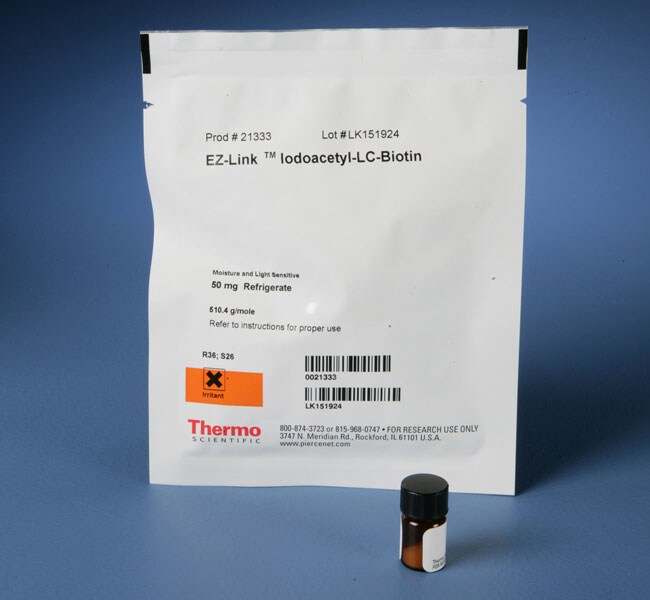
Thermo Scientific EZ-Link Iodoacetyl-LC-Biotin is a mid-length, haloacetyl-activated, sulfhydryl-reactive biotinylation reagent that forms stable, irreversible thioether bonds at alkaline pH.
Features of EZ-Link Iodoacetyl-LC-Biotin:
• Protein labeling—biotinylate antibodies or other proteins for use in protein methods
• Membrane-permeable—can be used to label inside cells (intracellular)
• Thiol-reactive—reacts with sulfhydryls (-SH), such as the side-chain of cysteine (C)
• Iodoacetyl-activated—perform reactions in the dark at pH 7.5 to 8.5 in Tris or borate buffer
• Irreversible—forms permanent thioether bonds; spacer arm cannot be cleaved
• Solubility—must be dissolved in DMSO or DMF before further dilution in aqueous buffers
• Medium length—spacer arm (total length added to target) is 27.1 angstroms; contains hexylenediamine extension
Iodoacetyl-LC-Biotin is a haloacetyl-biotin compound for labeling protein cysteines and other molecules that contain sulfhydryl groups. This reagent specifically reacts with reduced thiols (-SH) in alkaline buffers to form permanent (irreversible) thioether bonds. The unique feature of Iodoacetyl-LC-Biotin is its extended yet chemically simple hexylenediamine spacer arm.
We manufacture biotin reagents to ensure the highest possible overall product integrity, consistency and performance for the intended research applications.
Biotinylation reagents differ in reactivity, length, solubility, cell permeability and cleavability. Three types of sulfhydryl-reactive compounds are available: maleimido, iodoacetyl and pyridyldithiol. Iodoacetyl reagents specifically react with sulfhydryl groups (-SH) at pH 8.3 to form permanent thioether bonds.
In proteins, sulfhydryls exist where there are cysteine (C) residues. Cystine disulfide bonds must be reduced to make sulfhydryl groups available for labeling. Hinge-region disulfide bridges of antibodies can be selectively reduced to make functional half-antibodies that can be labeled.
Applications:
• Electron microscopy studies on spatial relationships between proteins (Ref.1)
• Localizing the SH1 thiol of the myosin head using avidin-biotin complexes in electron microscopy (Ref.2)
| Code | Description |
|---|---|
| 21333 | Catalog Number: 21333 |

